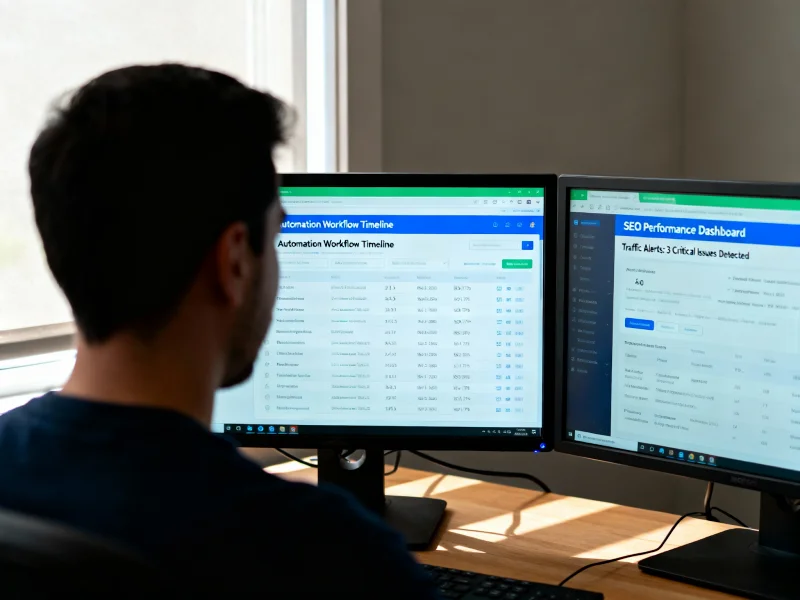How Does Keyword Intent Impact SEO?
Understanding keyword intent is crucial for achieving better SEO results. It aligns your content with user goals, which enhances engagement and decreases bounce rates.
So, how does keyword intent impact SEO? Keyword intent influences how search engines interpret content relevance and how users interact with your site. When you align your content with the user’s intent—whether they’re seeking information, comparing products, or ready to purchase—you deliver a better experience, which can lead to improved search rankings and conversion rates.
There are different types of keyword intents, such as informational, navigational, and transactional, each affecting how you should structure your content. By optimizing your content according to these intents, you can improve user experience and drive conversions.
Recognizing the appropriate intent can significantly influence your SEO performance, opening doors to more effective strategies and better outcomes. There are many insights to be gained as you explore this topic further.
#HowDoesKeywordIntentImpactSEO
Key Takeaways
- Keyword intent is essential for aligning content with user goals, which enhances SEO performance and minimizes bounce rates.
- Recognizing the different types of keyword intent—informational, navigational, and commercial—can significantly improve your content creation strategies.
- Adapting content formats, such as utilizing blogs for informational queries and product pages for transactional searches, can lead to increased user engagement.
- Conducting comprehensive keyword research with tools like Google Keyword Planner is key to identifying high-intent keywords for effective targeting.
- Regularly reviewing search engine results pages (SERPs) and analyzing competitor approaches enables you to adjust your content to meet changing user needs and intents.
The Importance of Keyword Intent in SEO
Understanding keyword intent is crucial for effective content optimization in SEO. By aligning content with user goals, you can ensure that every page effectively addresses the questions behind search queries. Analyzing search engine results pages (SERPs) helps identify the primary intent types, guiding the depth and format of your content. For example, when creating informational content, it is important to provide comprehensive explanations, while transactional content should clearly outline products or services. Incorporating credible sources and multimedia elements builds trust and encourages user engagement, leading to longer time spent on your pages. This increased engagement signals relevance to search engines, which can positively impact your rankings. Ultimately, prioritizing keyword intent not only enhances user satisfaction but also reduces bounce rates and increases conversion opportunities. This focus makes keyword intent a vital aspect of effective SEO strategies. Additionally, [matching search intent](https://www.webfx.com/seo/learn/why-search-intent-matters-to-seo/) drives traffic and improves rankings by fulfilling user needs.
Types of Keyword Intent and Their Impact
Understanding directional and commercial intent is crucial for optimizing SEO strategies. Directional intent pertains to users who are looking for specific websites or pages, while commercial intent involves users who are researching products or services prior to making a purchase. Recognizing these two types of intent can significantly impact your content creation and improve your ranking on search engine results pages. By tailoring your approach to meet the needs of users, you can enhance the overall effectiveness of your SEO efforts. Satisfying [search intent](https://backlinko.com/hub/seo/search-intent) is a primary goal for search engines and should be a central focus in SEO strategies.
Navigational Intent Explained
Navigational intent is a crucial aspect of search engine optimization, as it reflects users who are looking for specific websites or pages they already know. Queries that demonstrate this intent often include brand names or URL-related terms, such as "LinkedIn login" or "Tesla official site." In these cases, users prioritize quick access to their desired information rather than exploring other options. As a result, they typically skip typing a URL directly and opt for search engine results instead. High click-through rates (CTR) for top-ranking results indicate their immediate relevance, while limited exploration suggests that users are unlikely to click on alternatives if their primary target is not visible. To effectively cater to navigational intent, brands should ensure that their official pages rank prominently in search results and consider implementing structured data to improve visibility. [Rankings for branded queries](https://www.getfound.id/glossary/navigational-intent-in-seo/) are essential for capturing traffic and preventing competitors from diverting users.
Commercial Intent Overview
Commercial intent is a crucial factor in the decision-making journey of consumers who are evaluating products or services prior to making a purchase. This intent reflects users who are actively researching and comparing options, seeking expert reviews, or assessing specific features. Positioned between informational and transactional intent, commercial intent is often recognized through keywords such as "best," "review," "compare," or particular brand names. Individuals with commercial intent are typically in search of detailed, actionable information to help them finalize their decisions. It is essential for marketers to optimize their content to meet these needs. By understanding and addressing this intent, businesses can effectively support consumers during this important stage of their buying journey.
How Keyword Intent Influences User Experience
Understanding keyword intent is crucial for enhancing user experience, as it has a direct impact on engagement levels and helps lower bounce rates. When content meets user expectations, visitors are more inclined to spend additional time on the page, resulting in greater satisfaction. This alignment builds trust and encourages users to explore related content, which in turn improves overall site performance. Providing clear and relevant information not only supports users in their search but also contributes to a positive browsing experience.
Intent Alignment Improves Engagement
Aligning content with user intent significantly enhances engagement by ensuring that visitors can quickly and effectively find the information they need. When content meets specific user requirements, especially those related to commercial or transactional goals, it increases relevance and builds trust. For example, pages tailored for transactional intent, such as product comparisons or checkout processes, help to minimize decision-making challenges, contributing to higher conversion rates.
Reduced Bounce Rates
When content does not align with user expectations, it often results in increased bounce rates, underscoring the importance of understanding keyword intent in enhancing user experience. Mismatched content—such as directing users searching for information to product pages—can lead to immediate dissatisfaction, causing users to leave quickly. Search engines like Google recognize this disconnect, interpreting it as low relevance and reflecting it in higher bounce metrics.
On the other hand, aligning content with user intent, particularly by utilizing long-tail keywords, can effectively reduce bounce rates. For example, dedicated how-to blogs or transactional pages that include clear calls to action tend to keep users engaged for longer periods. By concentrating on user scenarios and optimizing content for intent, websites can boost engagement and improve their search rankings. Satisfied users are less likely to exit, contributing to a more favorable online experience.
Increased Time on Page
Recognizing the importance of keyword intent is essential for content creators aiming to enhance user engagement and increase the time visitors spend on their pages. By aligning content types—such as tutorials for informational intent or product listings for transactional intent—creators can effectively meet user expectations, leading to longer sessions. Analyzing search engine results pages (SERPs) can provide insights into structures that satisfy user intent while reducing the likelihood of pogo-sticking.
To improve user retention, it is important to minimize cognitive friction by offering clear and immediate answers. Optimizing content for mobile formats is equally vital, as it caters to users seeking quick access. Addressing both explicit and latent user needs can lead to deeper engagement. Including social proof elements, such as testimonials, along with the use of visual aids, can also enhance user interactions. This approach creates a comprehensive user experience that captures attention and encourages exploration of additional content.
Strategies for Optimizing Content Based on Intent
Optimizing content based on user intent requires a strategic approach that tailors formats and structures to specific search behaviors. For informational intent, using blogs and videos can effectively engage users, while product pages are essential for transactional queries. Analyzing the top search engine results pages (SERPs) reveals the dominant content types, such as listicles for "how to" queries, which can guide content creation. Commercial-comparison content, such as product showdowns, is ideal for users in the research phase. Including detailed specifications on product pages enhances the user experience for transactional searches. It is also important to align the content's tone—whether educational, persuasive, or entertaining—with the search intent. This thoughtful strategy can significantly enhance SEO results and provide valuable support to users.
Best Practices for Conducting Keyword Research
Conducting effective keyword research is crucial for attracting targeted traffic and enhancing SEO performance. Utilizing tools such as Google Keyword Planner and Ahrefs can help you analyze search volume and competition, making it easier to identify relevant keywords that face less competition. A balanced strategy that includes both short-tail and long-tail keywords allows you to capture a wider array of search queries. Insights from "People also ask" and related searches can reveal subtopic opportunities that can be beneficial to your content strategy.
It's important to prioritize keywords based on user intent, whether it is commercial, informational, or transactional, to ensure that your content aligns with what users are looking for. Analyzing competitors, optimizing your content, and implementing technical strategies will further refine your keyword targeting. By following these practices, you can enhance your visibility and engagement in search results.
Leveraging Keyword Intent for Enhanced Conversion Rates
Effectively leveraging keyword intent can significantly improve conversion rates by aligning content with the specific needs and desires of users. By focusing on high-intent keywords such as "buy," "cost," or "best," businesses can attract users who are ready to make a purchase. Creating transactional content that simplifies buying decisions—through clear calls to action, transparent pricing, and customer reviews—addresses the unique goals of users at the bottom of the sales funnel.
Content that aligns with user intent also enhances engagement and dwell time, which sends positive signals to search engines about its value. When there is a misalignment between content and intent, it can lead to bounce rates that negatively impact both SEO performance and conversions. By regularly analyzing and adapting to user intent across various channels, marketers can identify areas for improvement in their strategies and better target profitable customer segments, ultimately driving higher conversion rates.
Conclusion
In summary, understanding keyword intent is essential for developing effective SEO strategies. By recognizing the various types of intent—informational, directional, transactional, and commercial—marketers can create content that truly addresses user needs. This alignment enhances the user experience and contributes to higher conversion rates. By applying best practices in keyword research and optimization based on intent, businesses can maintain their competitive edge and stay relevant in an ever-evolving online landscape. As a result, this intent-driven approach—championed by Authority Solutions®—leads to improved SEO performance and long-term digital success.
Frequently Asked Questions
How does keyword intent impact SEO performance?
Keyword intent impacts SEO by aligning content with what users are truly searching for. When your pages match searcher expectations—whether informational, navigational, or transactional—they tend to rank higher, attract more clicks, and retain visitors longer.
What are the main types of search intent?
There are four main types of search intent: informational, navigational, transactional, and commercial. These different types of search intent reflect the specific intent of the searcher. Recognizing these types of search intent allows you to align your SEO content with the user search intent, enhancing relevance and visibility.
How does understanding search intent help you rank higher in search?
Understanding search intent allows marketers to create content with search intent that ranks well on search. This alignment ensures that your specific keyword or target keyword resonates with the intent of users, making your pages more likely to appear when someone enters a term into a search engine.
Why is search intent analysis crucial for SEO success?
Search intent analysis is crucial for SEO because it uncovers the intent behind the search and reveals how users behave online. This intent analysis guides the creation of relevant content, helping SEO experts develop strategies that support ranking higher in search and improved engagement.
How do SEO tools help determine search intent?
SEO tools like Google Search Console or the Keyword Magic Tool help determine search intent by analyzing queries, click-through rates, and user behavior. These tools expose search intent behind keywords and highlight which ones carry high buyer intent or informational intent keywords.
What is the value of optimizing for search intent in content creation?
Optimizing for search intent ensures your content matches the intent behind a user’s search query. This strategy creates better alignment between content and searcher intent, which means search engines understand your content’s relevance and are more likely to rank it prominently.
What role do branded keywords play in intent-driven SEO?
Branded keywords often signal specific search intent or intent to buy, as users already recognize your brand. Including these in your strategy supports content with search intent that targets users deeper in the funnel, improving the likelihood of conversion.
How do you perform intent analysis using keyword research?
To conduct effective intent analysis, begin with powerful keyword research. Identify intent keywords that match each type of search. Use tools like Google Search Console and Keyword Magic Tool to analyze keyword difficulty, high search volume, and search for keywords that reflect intent behind the query.
Why is understanding the intent behind the search so important?
Understanding the intent behind the search helps ensure you’re not just chasing keywords but fulfilling needs. When you understand the search, you create value by producing content that users actually want—this is why search intent is essential and intent so important in content marketing.
How do different types of search affect your SEO strategy?
The different types of search require varied content approaches. For example, keywords are often tied to informational intent keywords for blogs, while intent keywords are often tied to products or services. Knowing this helps enhance your SEO strategy and adjust to the evolving search landscape.









